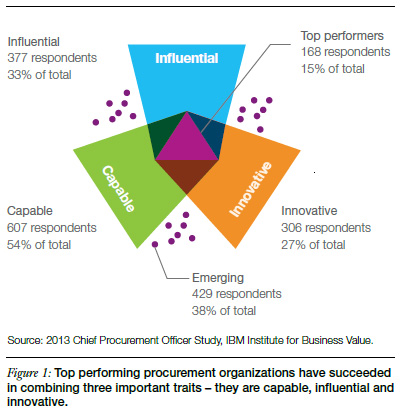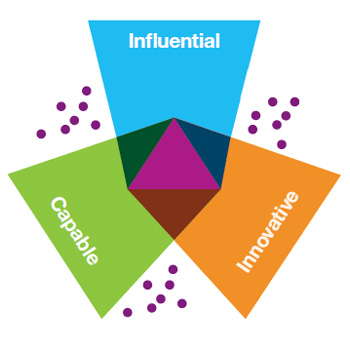Improving Competitive Advantage Through Procurement Excellence
The Chief Procurement Officer Study is based is the largest procurement study ever conducted by the IBM Institute for Business Value, and among the largest procurement studies produced anywhere.
To the uninitiated, procurement may seem like a “back office” support function.
In fact, it can be a significant contributor to organizational value and a driving force behind gaining competitive advantage.
To understand the links between procurement and enterprise performance we conducted one of the largest known survey of procurement leaders to harvest insights on what actions and decision are driving positive results.
We found that to maximize its impacts on the organization, the procurement function must have a strong set of fundamental capabilities, become an influencer throughout the organization and embrace innovation.
The Chief Procurement Officers (CPOs) of organizations that demonstrate these attributes often have a seat at the corporate leadership table – while their under performing counterparts are relegated to the more mundane tactical roles.
Like other strategic functions in the enterprise, procurement’s role continues to evolve. From 2008 to 2012, many companies looked to procurement to help facilitate aggressive cost-cutting targets necessitated by a global economic downturn.
As economic realities continue to shift, the procurement function must again adjust. To understand what actions and decisions have led to success in the past, and to derive insights on what responses might work best in the future, we surveyed 1,128 CPOs from organizations with annual revenue in excess of US$1 billion.

Through our research, we discovered three key points of differentiation that separate high-performing procurement organizations from the pack (Figure 1):
1. Effective delivery of traditional procurement capabilities
2. Influence within the enterprise over purchasing and strategic decisions
3. Delivery of innovative ideas from a diverse range of inputs
The few procurement organizations that consistently deliver on all three of these important dimensions, approximately 15 percent of the organizations we surveyed, offered unique insights into what works best to move the procurement needle in the right direction.
CPOs from these high-performing organizations maintain focus on procurement fundamentals, extend procurement’s value through collaboration and develop new capabilities to address emerging procurement challenges.
Fundamental capabilities form the base of strong procurement performance
The goal for procurement organizations is to dependably deliver value to the companies they serve. To consistently deliver this benefit to the enterprise, the procurement function must, at a minimum, be a master of the fundamentals. Top performers get these basics right every time.
Regardless of the specific mission any individual CPO has carved out for his or her organization, the primary mission is to reduce procurement costs.
Advancing this cause depends on a core set of procurement capabilities that top performers achieve through consistent application of the right performance metrics, effective upward communication about performance success and standardization of the processes and procedures that define the function.
Top performers are influential in the organizations they serve
Delivering traditional procurement capabilities is important, but the hope of most CPOs is to influence and improve the way the business operates. In this regard, influence is another key element of procurement performance, but fewer procurement organizations seem to excel in this area.
Top-performing procurement organizations recognize the value of collaboration. Compared to their lower-performing peers, these top performers excel at both internal collaboration – collaboration between employees – and external collaboration – collaboration with customers, partners and suppliers.
Top performers bring innovative ideas into the organization
While about one half of procurement organizations are effective and a third are influential, even fewer are innovative. Those that are indicated they look for innovation across a wide range of sources.
They achieve results by staying ahead of change. For example, leading procurement organizations embraced fundamentals like automation and collaboration before they were common.
Similarly, top performers are currently at the leading edge of risk management, procurement analytics, and talent management, and we expect the focus on these key three areas will continue to confer advantage to the CPOs who excel in these areas.
The IBM Institute for Business Value executive report, “Chief Procurement Officer Study: Improving competitive advantage through procurement excellence” examines the practices of those select few procurement organizations that have developed and mastered the capabilities, influence and innovation that enable them to contribute to the competitive advantage of their enterprises.
The report looks at what separates out performers from the rank-and-file organizations that fall short. And, finally, the report provides a road map that CPOs can follow that will enable them to begin emulating the practices of out performers to positively impact the competitive position of their organizations.
Article Topics
IBM News & Resources
Creating Business Value With Embedded Sustainability The Circular Supply Chain with Lisa Dender, Global Lead for Product Chemical Regulations at IBM Talking Supply Chain Podcast: On the Road at MHI with Noelle Russell Cultivating Relentless Supply Chain Agility at IBM The Retail Supply Chain is Hot Hot Hot The Rebound Podcast: We’re Going to Need a Bigger Boat? New IBM study addresses trucking’s future through a digital transformation More IBMLatest in Supply Chain
Baltimore Bridge Collapse: Impact on Freight Navigating TIm Cook Says Apple Plans to Increase Investments in Vietnam Amazon Logistics’ Growth Shakes Up Shipping Industry in 2023 Spotlight Startup: Cart.com is Reimagining Logistics Walmart and Swisslog Expand Partnership with New Texas Facility Nissan Channels Tesla With Its Latest Manufacturing Process Taking Stock of Today’s Robotics Market and What the Future Holds More Supply Chain













